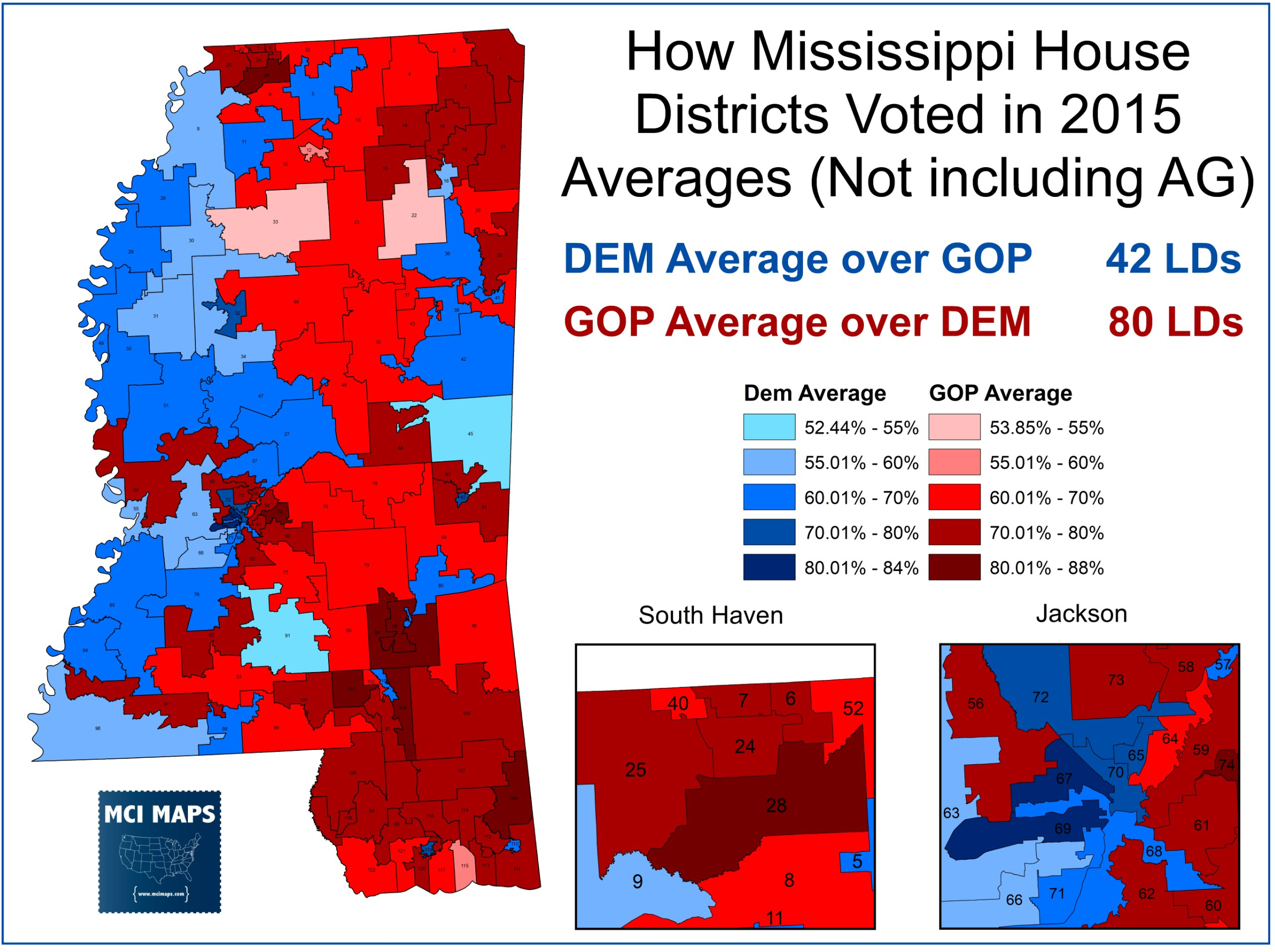Last night, Mississippi’s longtime Democratic Attorney General, Jim Hood, secured his party’s nomination for Governor. He will face a November general against the winner of the GOP runoff. While Waller and Reeves go onto a runoff, Hood can continue his focus on the general. Hood is by far the strongest candidate for Governor the Democrats have had in some time. The last serious shot Democrats had at Governor was 2003, when Incumbent Democrat Ronnie Musgrove lost re-election. Hood, originally elected Attorney General in 2002, has been the lone statewide bright spot for Mississippi Democrats. However, despite Hood’s strength, he still faces a tough challenge winning Governor in Mississippi. That challenge is just not because of the state’s GOP lean, but also due to an obscure law that only exists in Mississippi – a law left over from the era of Jim Crow.
Mississippi’s Jim Crow Law
Saying any law or policy is a “Jim Crow” policy invokes the memory of segregation and violence toward African-Americans. It is not a word to be used lightly. However, this law very much falls in line with this phrase. The law in question requires that any candidate for statewide office win a majority of the popular vote in the state AND win a majority of the State House districts. If both of these things are not achieved, the state house decides the winner. This law was put into the Mississippi constitution in 1890 and was specifically designed to ensure no African-American candidate could become a statewide office holder. Mississippi’s slavery history resulted in it having the highest African-American share of the population in the nation. As a result, white leaders worried about an African-American candidate, or a pro-black candidate, winning Governor or other offices. Voter registration was likewise denied to African-Americans through poll taxes, literacy tests, and outright violence. But the law in question was used as a last resort to ensure the pro-segregationist legislature could have a say if someone won with under 50% or under half the districts.
In the modern era, this law is rarely thought about. African-Americans were finally able to register and vote in the late 1960s, but they have not been able to get an African-American elected statewide. The law has not been used to overturn the popular will of the voters in decades. The last time the law was invoked was 1999, when Democrat Ronnie Musgrove won a plurality win and tied in the number of legislative districts. There was a vote in the State House, with the Democratic majority confirming Musgrove’s win. The 1991 and 1995 Lt Governor elections both saw plurality wins, but in both cases the 2nd place candidate conceded defeat before any legislative vote.
Those three instances proved to be less controversial; but this time could be very different thanks to race and party.
Mississippi’s Current House Makeup
Mississippi Democrats put the law into the 1890 constitution and did nothing to repeal during the decades of dominance in the state. It wasn’t until 2011 that Democrats lost complete control of the Mississippi legislature. They lost a net 9 seats in the House, the same year Jim Hood was re-elected with over 60% of the vote.
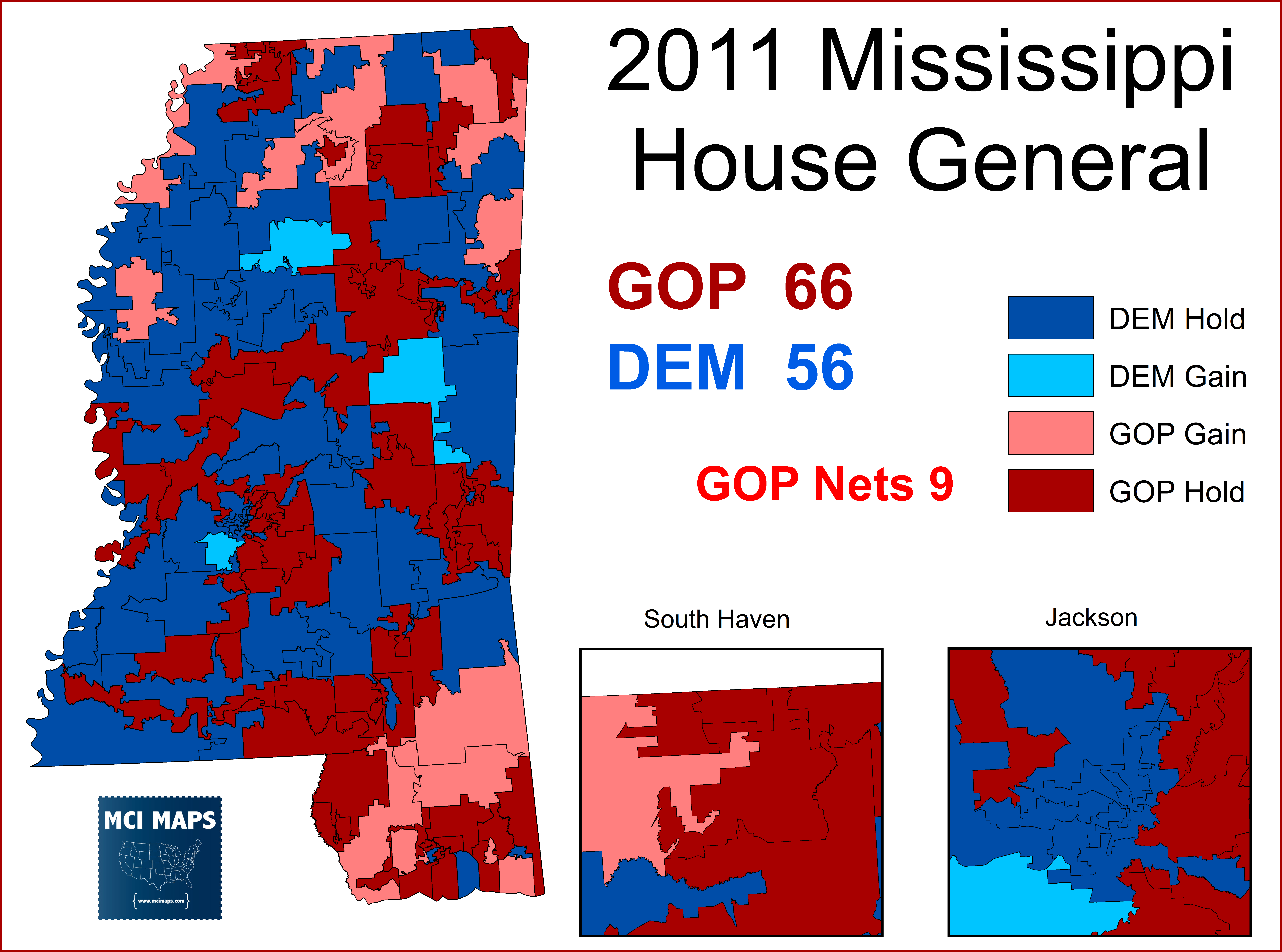
After the loss, more Democrats switched parties and Republicans got to redraw the map for the decade’s redistricting. After 2015’s elections, the Republicans attained a super-majority in the state house. They currently sit on over 70 seats.
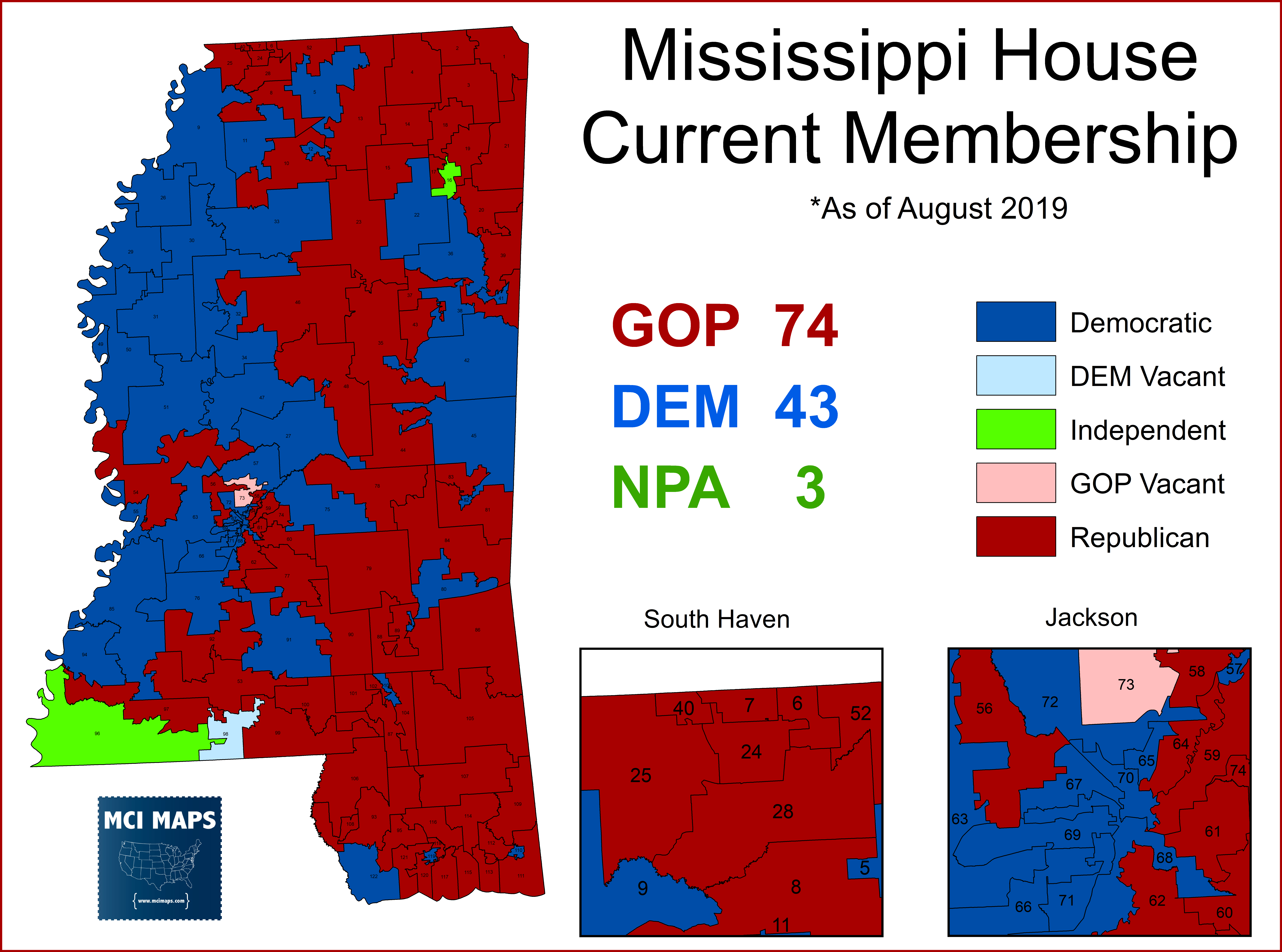
If Hood wins the most votes but is forced to go before the state house, it is very debatable the GOP majority picks him; especially if he falls under half the house districts. It won’t be hard for members to say “I’m going with what my constituents want, and they didn’t vote for him.”
Race and Politics in Mississippi
Mississippi has long been regarded as the most racially polarized state in the nation when it comes to voting. While African-Americans are around 90-10 Democratic across the nation, Mississippi whites are nearly the reverse for Republicans. This used to be the case for down-ballot offices. Democrats controlled the Mississippi legislature for over a century and still had statewide wins through the 1990s. In fact, the graph below shows how Democrats in Mississippi dominated state politics for so long, and the loss of control occur very recently.
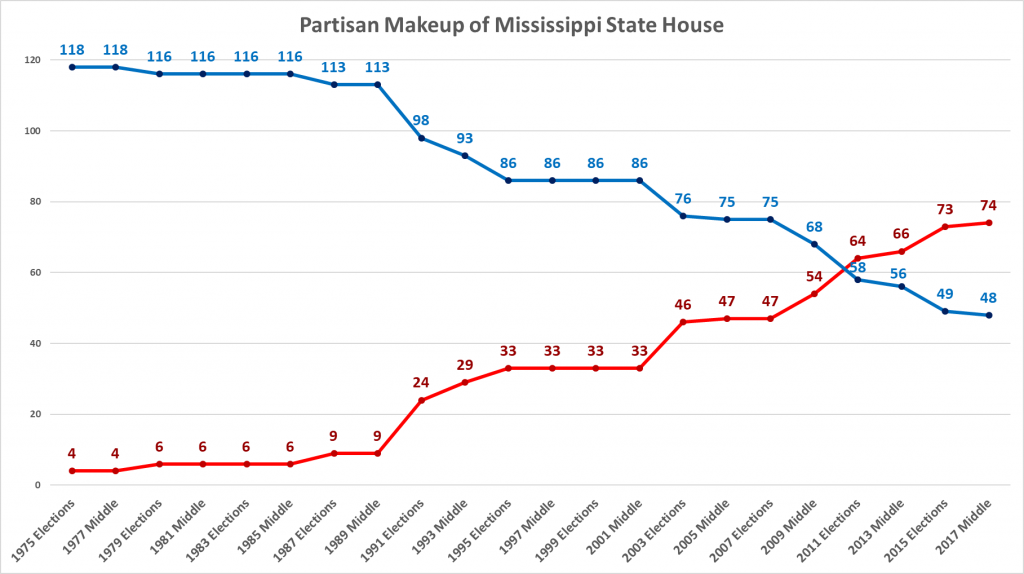
These days, Democrats in Mississippi struggle with white voters at all levels of government. A vast majority of the Democratic delegation resides in districts with more black than white members; and a majority of the Democratic delegation is African-American. At this moment, only five members of the State House democratic caucus sit in districts with more white residents than black ones.
This shift in general election voting has also applied to primaries as well. Mississippi doesn’t have partisan registration, and as such voters can pick which primary to vote in. Until just a decade ago, many conservative Mississippi whites would still vote Democratic in primaries, and maybe ticket split in generals. Nowadays, Democratic primaries in Mississippi are heavily African-American. This is perfectly demonstrated by the Presidential primary. In 2008, the Mississippi Democratic primary was nearly evenly split between black and white voters. In 2016, however, the primary was 71% African-American. Those conservative whites moved to the GOP.
The State House Map
The anti-Democratic nature of the Mississippi election law is made worse by the fact the state house districts are drawn by lawmakers themselves. The law basically creates an electoral vote system for the state. However, the nationwide’s electoral vote is at least propped up by the fact state borders don’t regularly change and have some logic to them. The state house map, like many legislative maps, is filled with jagged lines, political gerrymandering, and little community interest. Below is a google map of the districts. I create this so you can zoom in and see how bad these borders can be.
The results of the map is 80 white districts and 42 African-American ones. This proportion falls closely in line with the state overall. However, due to the severe partisan/racial polarization, it means over 80 years are very favorable to the GOP. As the legend and color scheme show, few districts are actually close to evenly mixed – most are very homogeneous.
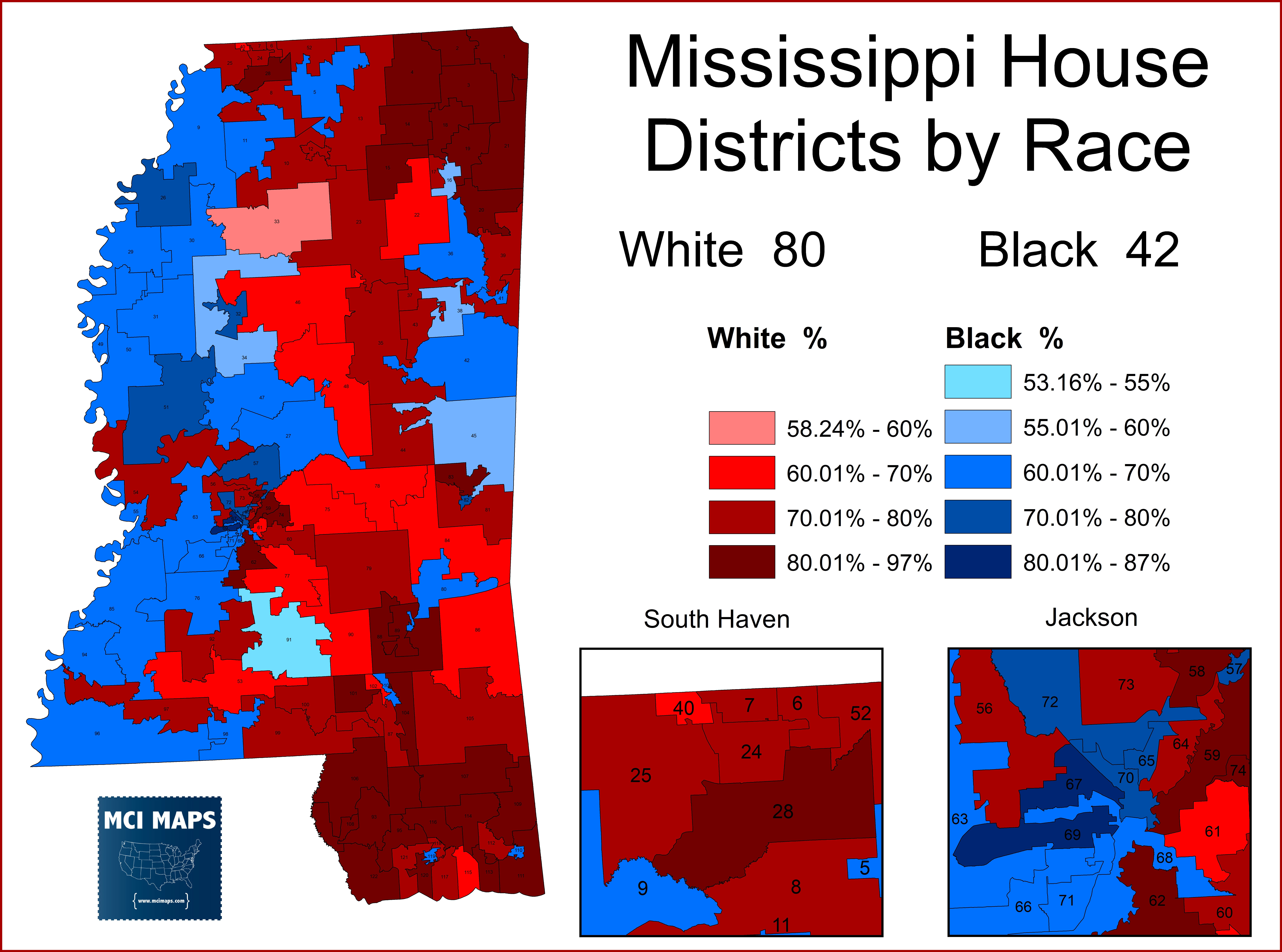
There is also the caveat that this data is census figures and doesn’t account for voter registration, voter turnout, or the fact 16% of Mississippi’s black population is disenfranchised via a broad lifetime felon ban on voting.
What we quickly find is that the racial breakdown of the map correlates with the partisan breakdown. The 2015 elections saw six of the seven statewide offices feature Dem vs GOP contests. Most Democrats fell right in the upper 30% column; with Jim Hood securing 55%. If we take Hood out and do a map of the Average Democratic and Republican share, the map is near identical to the race map.
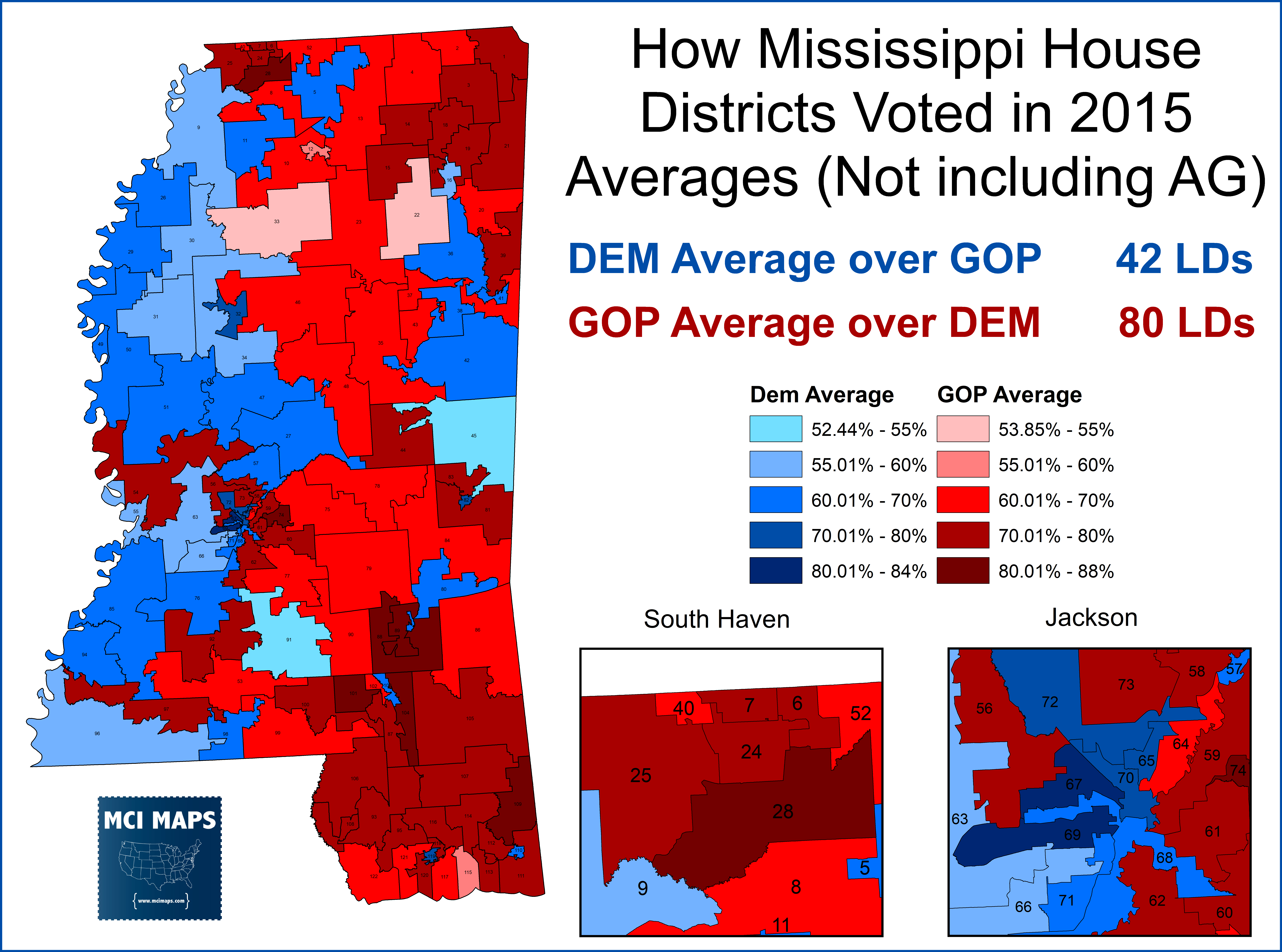
Every black district had a higher Dem average than GOP, and every white district had a higher GOP than DEM average.
Hood’s 55% re-election actually saw him take a majority of the state house districts.
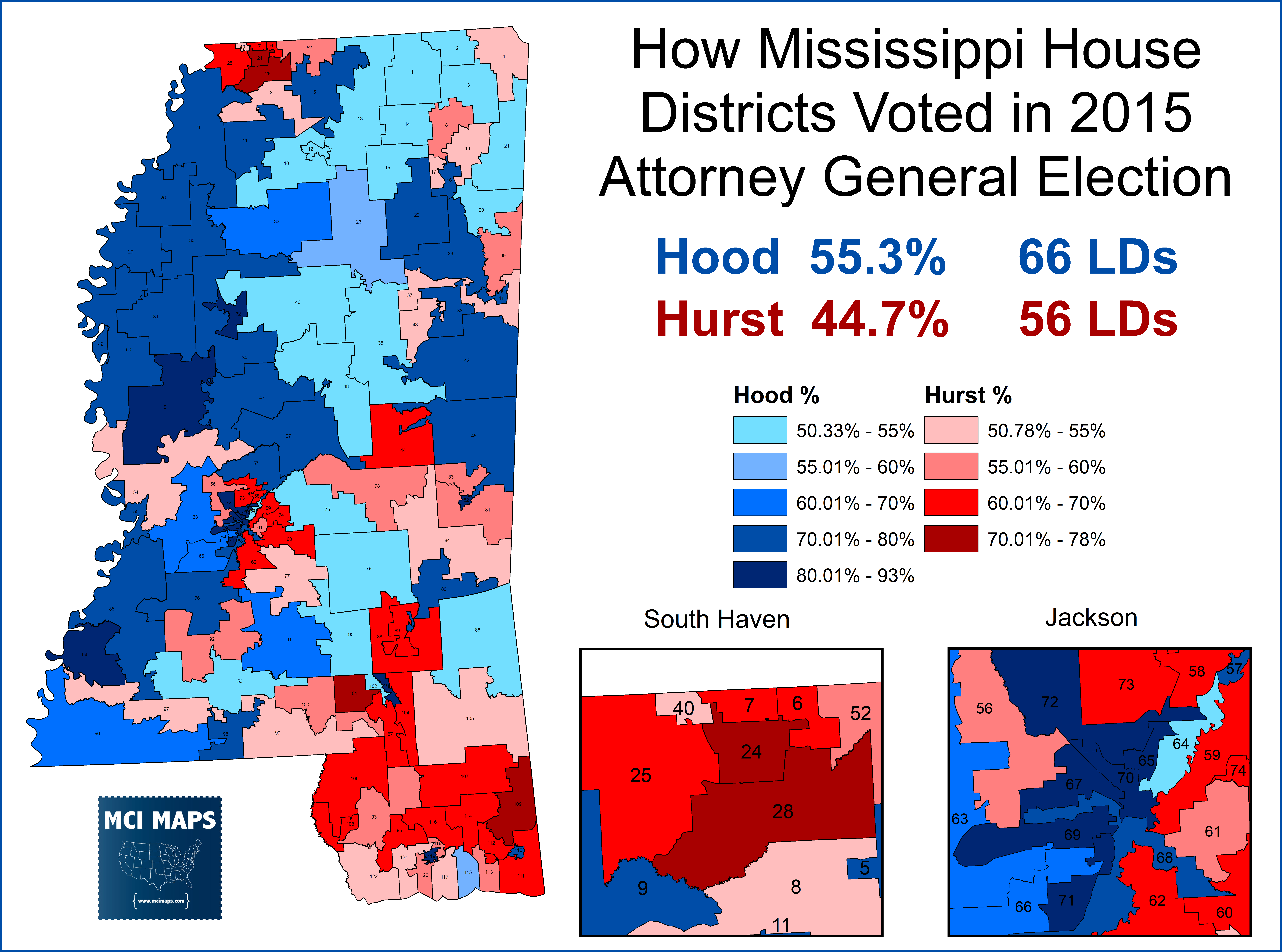
The win shows a Democrat can win a majority of the districts on the map. However, 9 of his winning seats were carried with under 52%. Its easy to see Hood doing just a few points worse and as a result falling under the 62 seats needed to avoid throwing the race to the house. All that light blue, in the northeast, an ancestral democratic region of the state, means Hood’s wins were very precarious. Of course, no one expects Hood to win a landslide in his Governor run. A Hood will would almost surely be very narrow and thus making winning a majority of seats very difficult. Hood outperformed the democratic average in every district of the state, but was much stronger in that ancestral region in the Northeast.
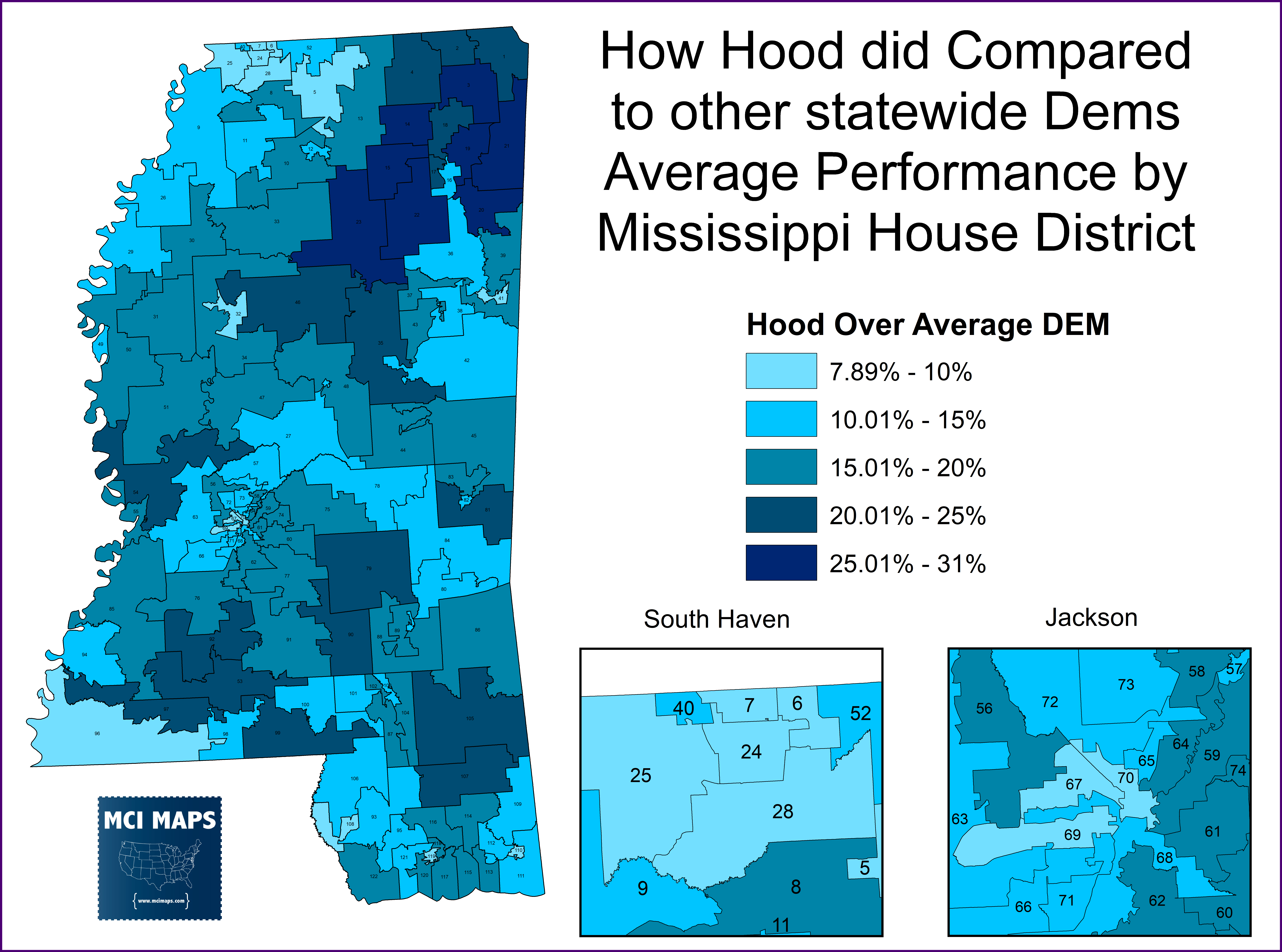
However, Hood’s win was still very much tied to race. The scatter-plot below shows the democratic average compared with the racial makeup of the seat. The correlation is extremely strong, with democratic averages getting steadily worse as a seat becomes whiter.
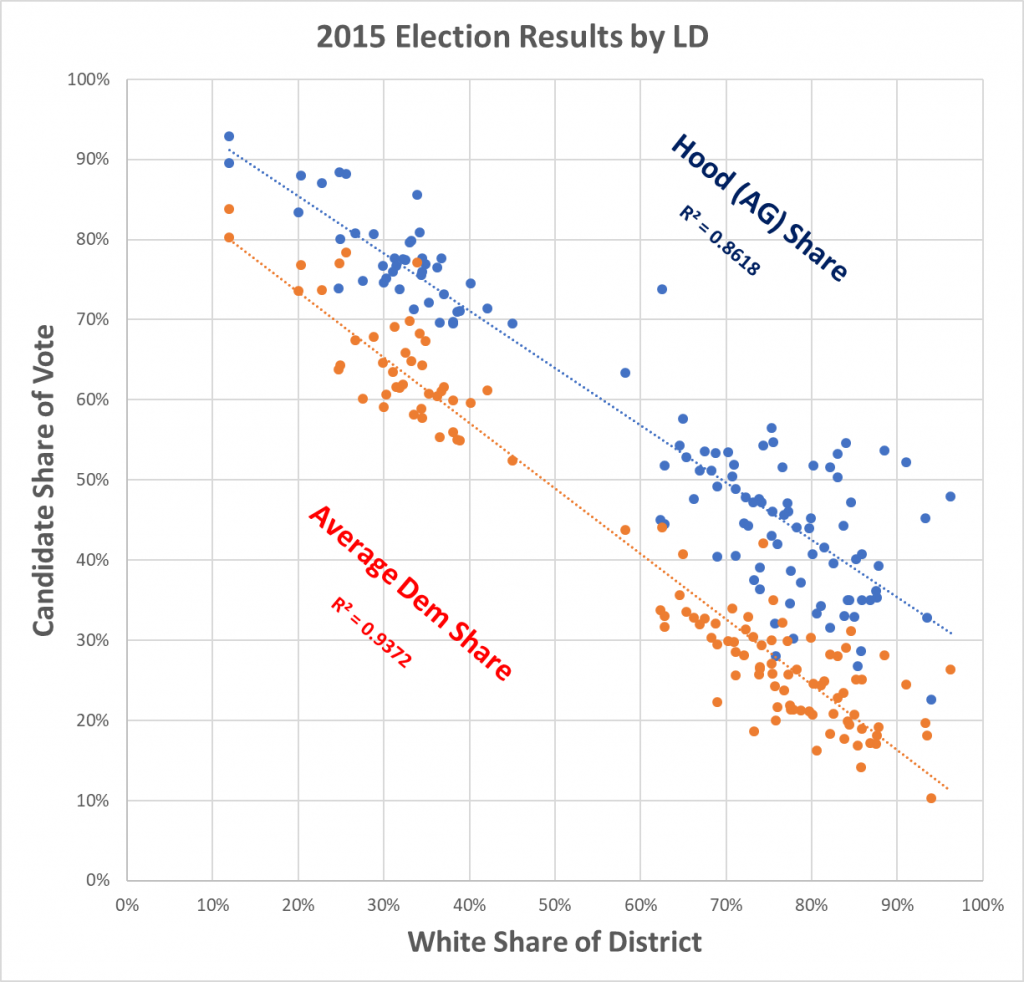
Hood, meanwhile, starts off higher than the Democratic average in heavily black seats and does manage to not drop off as much. However, he still sees a clear decline.
Mississippi’s state house map is overall very politically polarized thanks to race. The map below codes each district by its party loyalty in 2015.
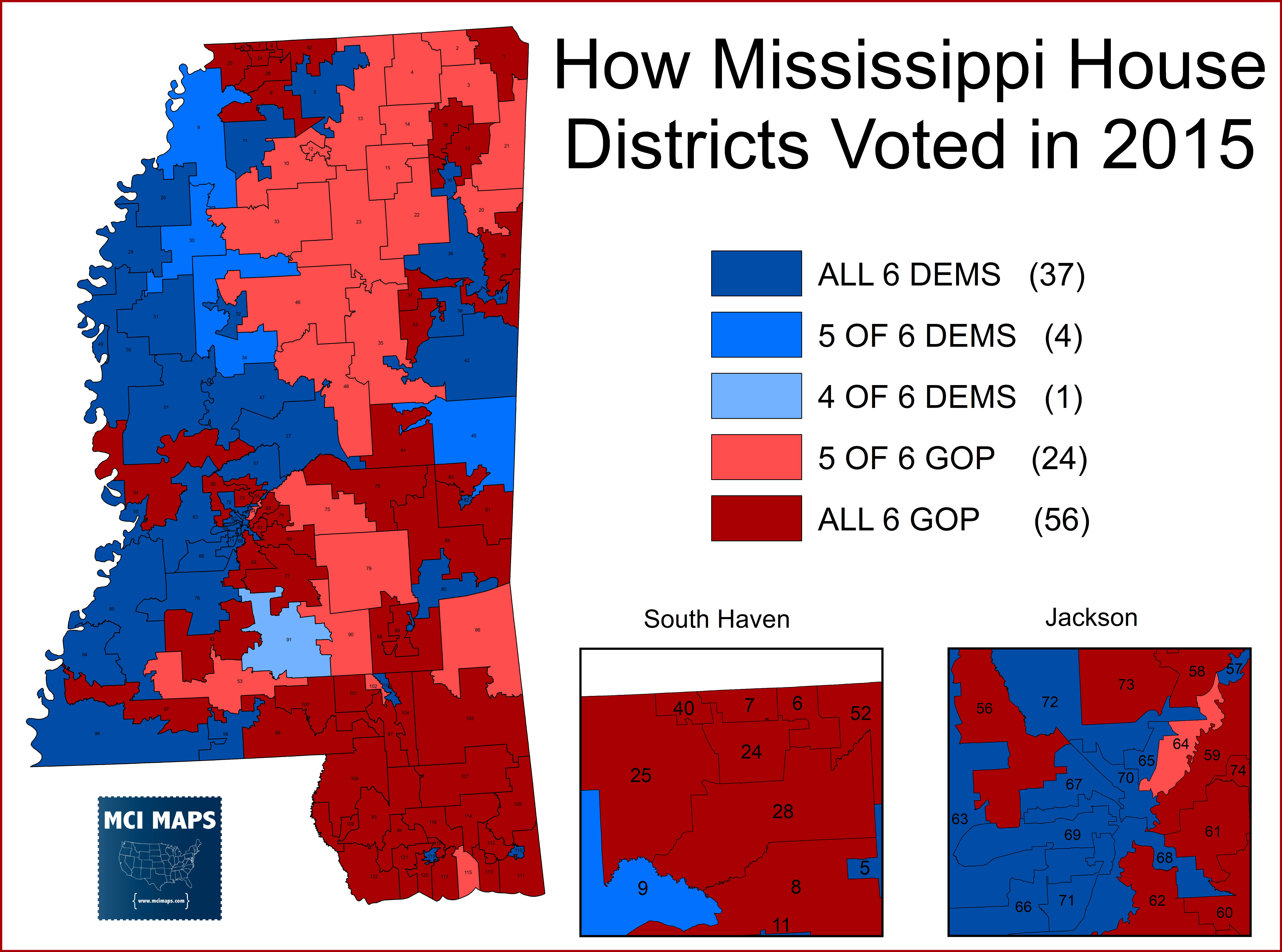
A vast majority of seats voted straight ticket for every office. Hood is the only Democrat to win any heavily GOP seats. Meanwhile, the democratic candidates for Governor and Agriculture Commissioner lost a few modestly African-American (but with large white minority) districts.
The worst showing Democrat was the candidate for Governor, ….. Gray. Gray was a shock primary winner and was a truckdriver before and during his campaign. He lost to incumbent…. Bryant in a landslide, but still took a vast majority of the African-American districts; losing a few of the more evenly split seats.
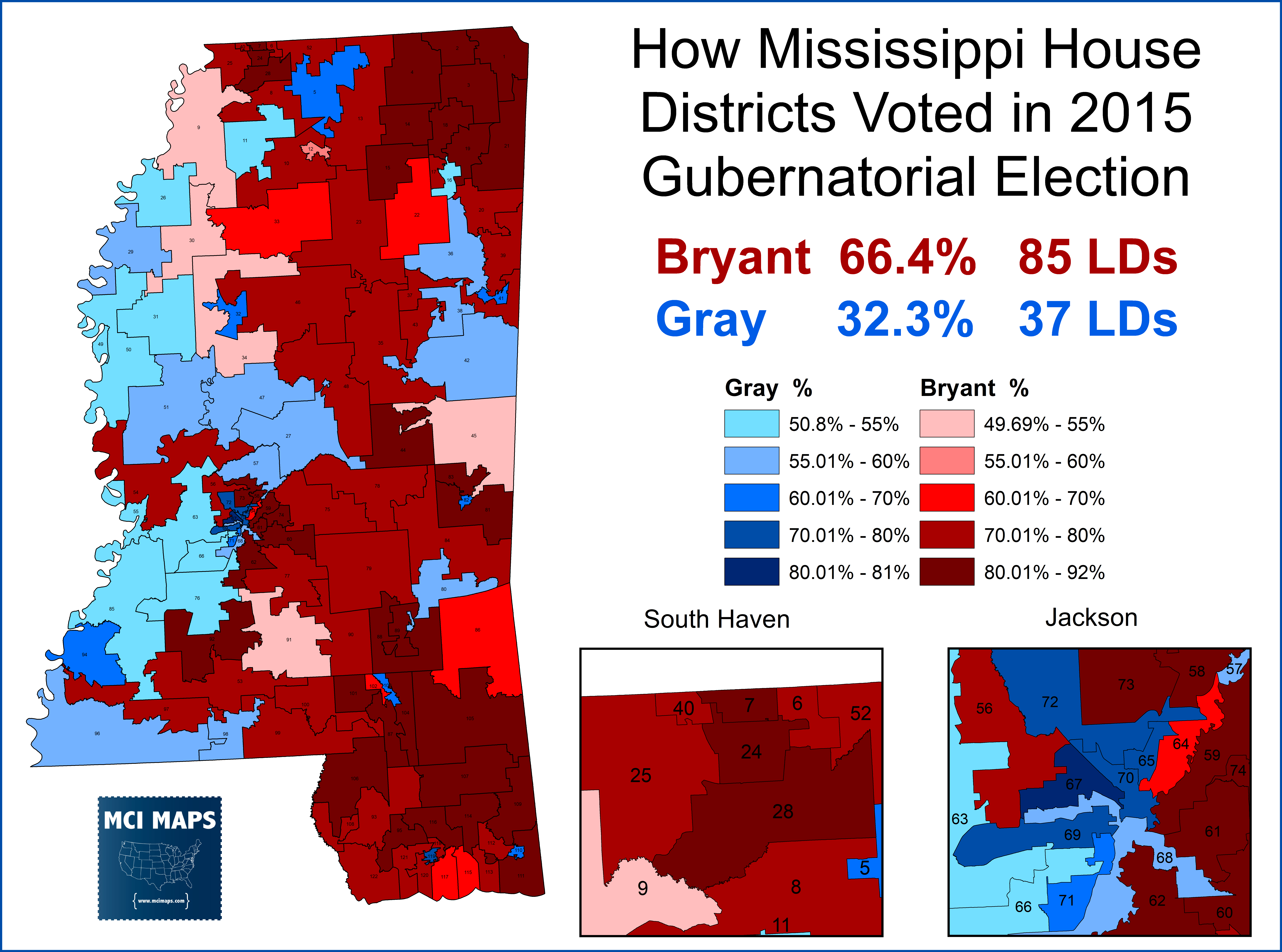
Mississippi’s racial and political polarization can realistically be summed up in this map below – where districts are coded by race and their 2015 loyalty.
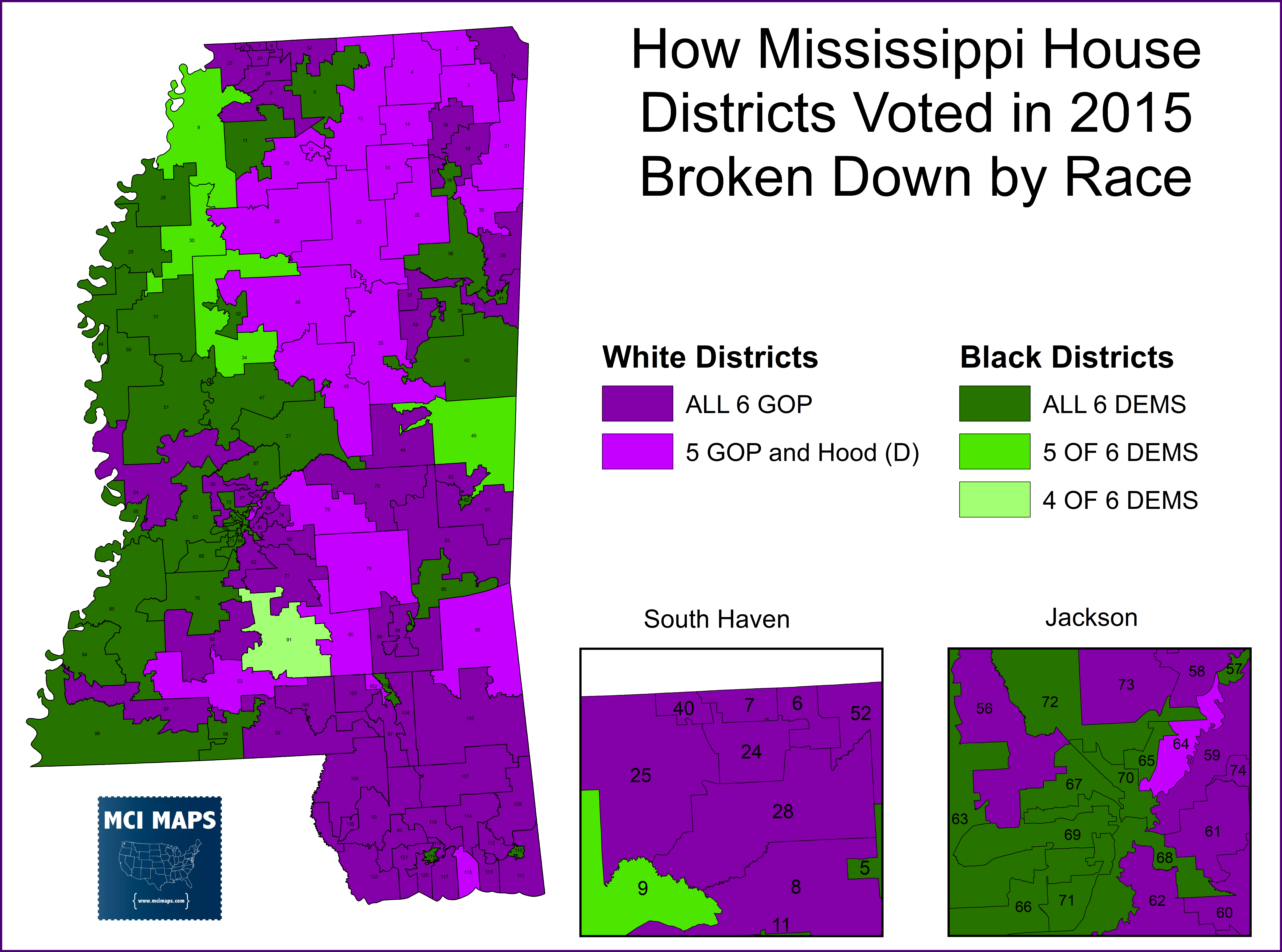
A vast majority of the white districts voted straight GOP, with Hood being the only crossover candidate.
Conclusion
Jim Hood is by far the strongest candidate Mississippi Democrats have had for Governor in a decade and a half. It is not impossible for Hood to poll off a win. However, the law, as it stands in Mississippi, means Hood will need a comfortable win to try and secure 62 house seats. If he winds up in a house vote, I don’t think there is any scenario where he becomes the next governor.

